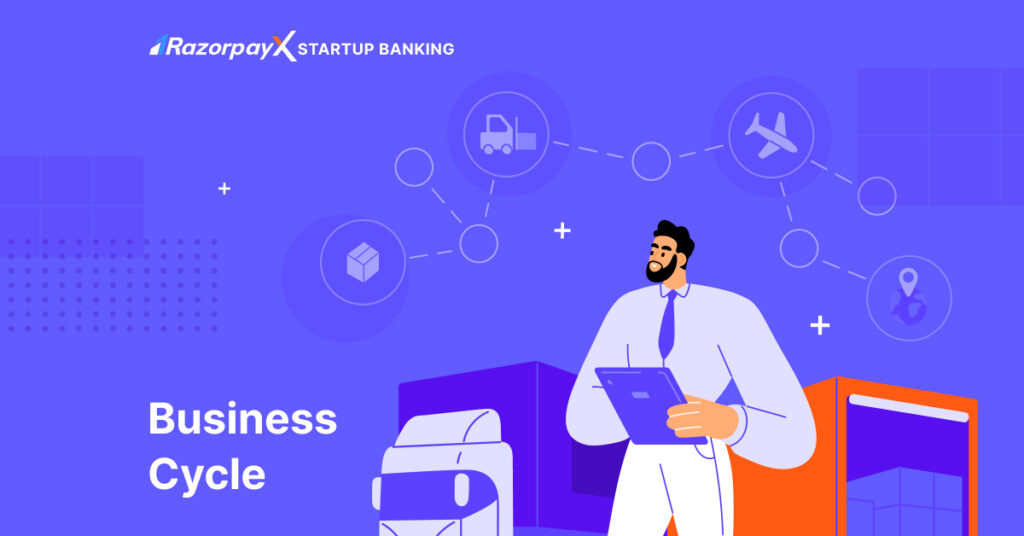Table of Contents
What is a Business Cycle?
A business cycle refers to the fluctuations in economic activity characterized by alternating periods of expansion and contraction.
Expansion is when the economy is growing, employment is high, and prices are steadily increasing. At the peak of the cycle, economic growth is at its highest, employment is at its highest, and prices have reached a peak.
During the contraction phase, economic growth slows, employment decreases, and prices start to fall. Finally, the trough is the lowest point of the cycle, where economic growth is at its lowest, employment is at its lowest, and prices are at their lowest.
These changes can be measured by the country’s Gross Domestic Product or GDP.
It is important to know how these cycles work since they form the macroeconomic context for everything that happens within the economy.
What Causes Business Cycles?
A number of factors contribute to the fluctuations in an economy.
Monetary policy: Changes in monetary policy, such as interest rate adjustments made by central banks, can affect the level of investment and spending in the economy.
Fiscal policy: Government spending and taxation policies can also have an impact on economic activity. For example, a decrease in taxes can stimulate spending and investment, while an increase in taxes can have the opposite effect.
Technological innovation: Advances in technology can lead to changes in the structure of industries, creating new opportunities for growth and investment.
Business investment: The level of business investment in the economy can fluctuate based on factors such as the availability of credit and the level of confidence in the economy.
Consumer confidence: Consumer confidence in the economy can affect the level of spending, with periods of economic uncertainty leading to decreased spending and investment.
International trade: Changes in international trade policies and economic conditions in other countries can also affect economic activity in a given country.
| Causes of Expansion | Causes of Contraction |
|
|
|
|
|
|
|
|
|
|
|
|
A business cycle is complete if one instance of expansion is sequentially followed by a single event of retraction.
The time it takes for this rise and fall of growth rate to take place is referred to as the length of a business cycle.
What Are the Different Stages of a Business Cycle?
There are six stages of a business cycle. These are:
- Expansion: An economic expansion is a period of economic growth.
- Peak: A peak is the highest point in the business cycle.
- Recession: A recession is a period of declining economic activity.
- Depression: A depression is a severe and prolonged downturn in economic activity.
- Trough or Bottom: The trough or bottom is the lowest point in the business cycle.
- Recovery: Recovery is the process of regaining strength after a downturn.
What is a Recession?
A recession happens when the collective economic activity of a country follows a downward spiral for a significant period of time.
Although there is no simple formula to decide when a fiscal downturn can be termed as a recession, a few basic pointers are generally used.
If a nation’s GDP records two successive quarters of retraction, then its economy is thought to be going through a recession.
With the emergence of newer and more advanced socioeconomic models, the accuracy of this projection has been under the microscope.
These modern modules have instead paid greater significance to certain specific indicators to determine whether a country is undergoing a recession. Such indicators can include but are not limited to-
- A major rise in unemployment in the country
- The housing market’s inability to provide optimal output
- Decreased retail sales
- Lack of individual and corporate spending
Theoretically, a period of recession can take place over just a few months. However, it often leaves a lingering effect on the country’s economy that can take a significant time to recover from.
What is Recovery?
As a country’s economy starts to expand again after a prolonged period of recession, it is referred to as a recovery. The onus remains on the government bodies of a country to take the necessary steps during a recession to ensure the journey to recovery can begin without further delay.
Some of the crucial decisions a government can take during a recession to expedite the scope of bouncing back from a downturn may include the following:
- Lowering interest rates
- Open market operations
- Quantitative easing
- Relaxed taxation norms
- Put money into public projects
- Introduce expansionary policies
- Fiscal stimulus, etc.
There are many notable indicators that can highlight a country’s economy beginning to recover from a recession, such as:
- Dropping unemployment rates
- Increase in discretionary expenses
- Growing GDP of a nation
- Notable business activities
Interestingly, experts in the field have noted that improvement in the condition of a country’s start-up market can also be a significant implication of its recovery from a recession. Therefore, businesses have to make adequate fiscal decisions in such a scenario to ensure they can successfully move ahead.
For one, start-ups can use the assistance of digital-first neo-banking facilities to streamline their monetary inflow and outflow during a period of recovery. With platforms like RazorpayX, such transactions can be comprehensively streamlined.
To elaborate, now you can open a RazorpayX-powered current account without any expenditure. Such an account allows your company to automatise vendor or tax payments and enables you to add new beneficiaries at a moment’s notice.
Moreover, its user interface is up-to-date with the latest state-of-the-art technologies. Therefore, you can integrate several accounting and business tools that you use for reaching your company’s strategic goals.
How is the Business Cycle Measured?
For Recession
Economists use the 3 D’s to determine the magnitude of the recession.
- Depth: Measured on the basis of how much employment, income, and sales rates are affected
- Duration: The period between the peak and trough of this specific business cycle is referred to as the period of recession
- Diffusion: Measured depending on the long-lasting and sprawling effect of a recession on large scale fiscal decision-making, industrial development, and regions of a country
For Expansion
Alternatively, financial experts refer to the 3 P’s when determining the scope of an economic expansion.
- Pronounced: Measuring the widespread impact of the economic boom on both individuals and collective entities like a corporation
- Pervasive: Depending on whether a larger portion of a country’s diverse communities had directly benefitted from the expansion
- Persistent: Based on the longevity of an expansion period, which is calculated from the trough of a business cycle to its subsequent peak
Managing Business Cycles
Availability of credit during the downturn of an economy is crucial in beginning its journey towards recovery. Therefore, platforms like RazorpayX can play a significant role in ensuring that businesses do not struggle due to working capital needs.
For instance, with RazorpayX corporate card facilities, you can avail of formal credit for your business without any requirements for collateral. Moreover, with an exponentially higher credit limit, you can rest assured about providing your company with an unrestrained liquidity boost so that it can stay afloat during volatile market conditions.
FAQs
How long does a business cycle typically last?
Although the time of completion for the business cycle can vary from one country to another, on average its length remains around five and a half years.
What is the GDP projection for India in the financial year of 2022-2023?
The Indian economy is projected to witness a 6.9% GDP growth in FY 2022-23.



